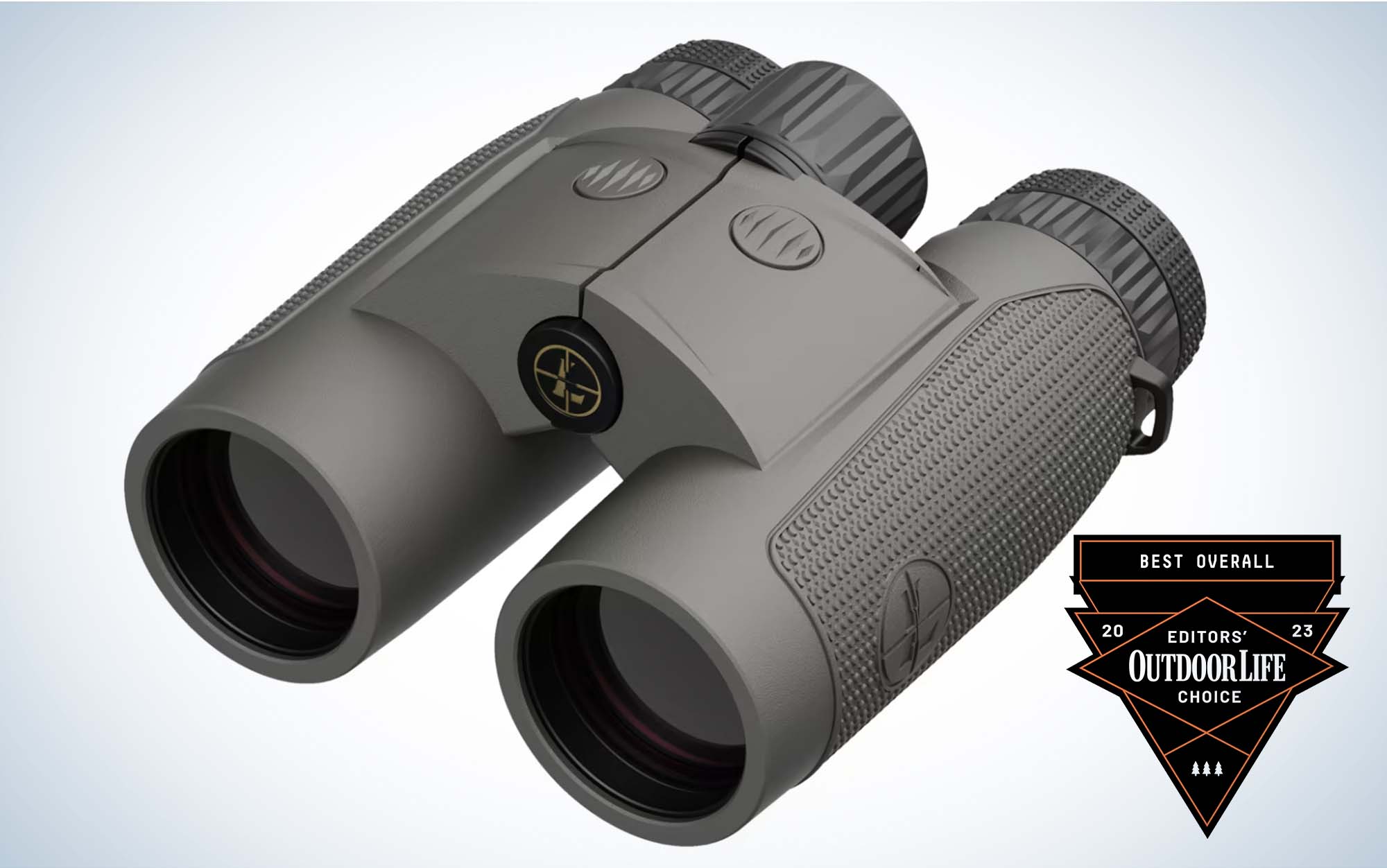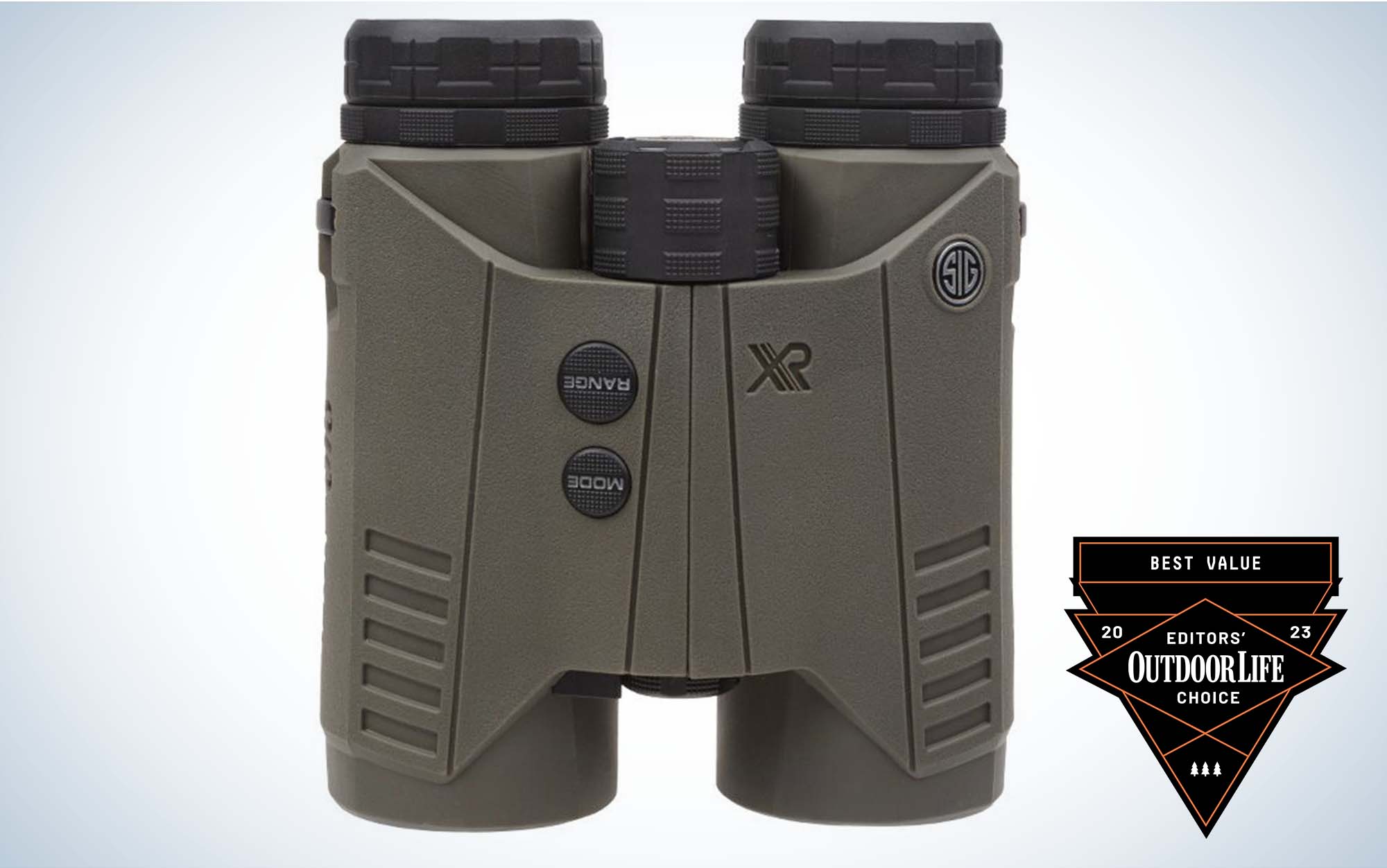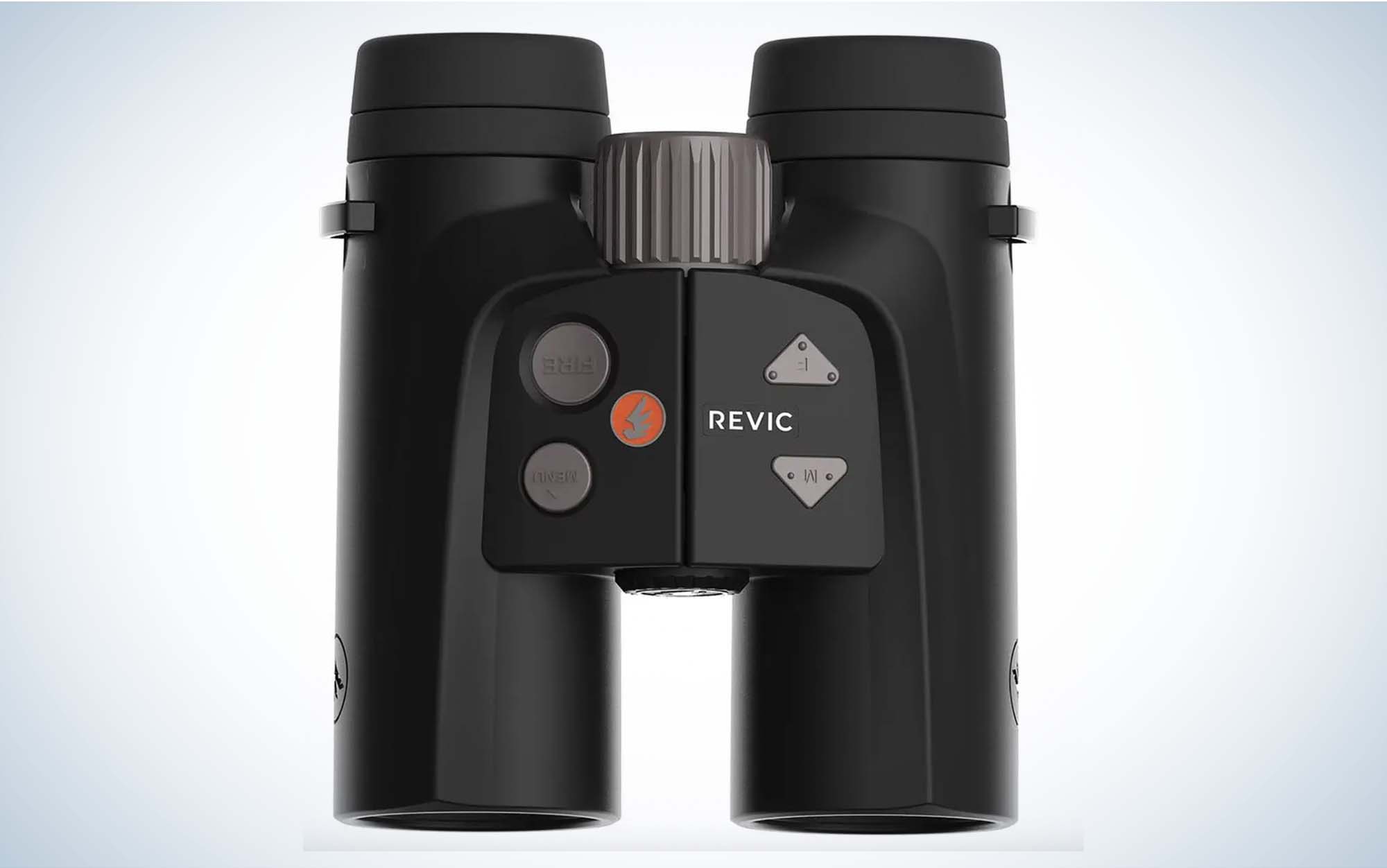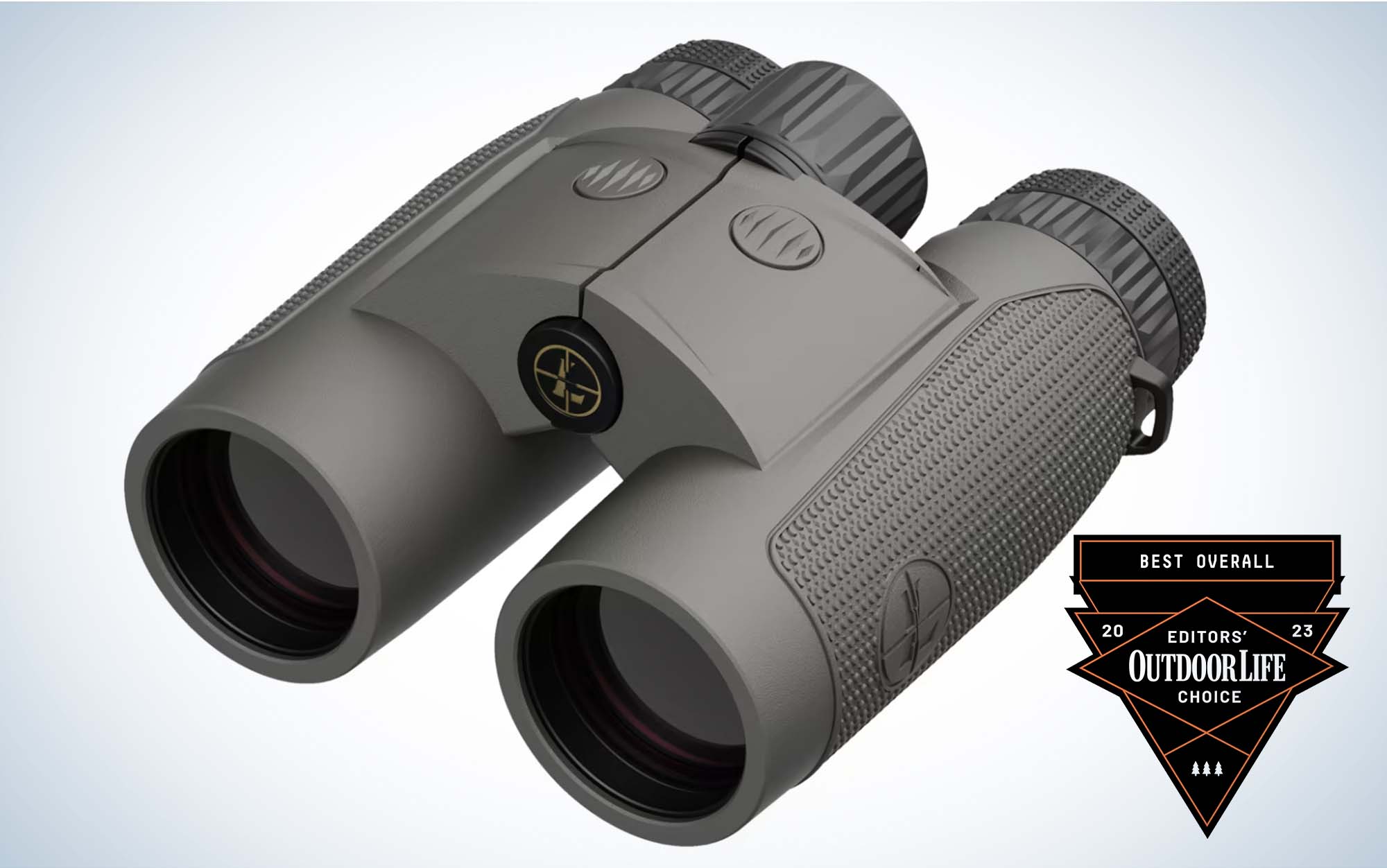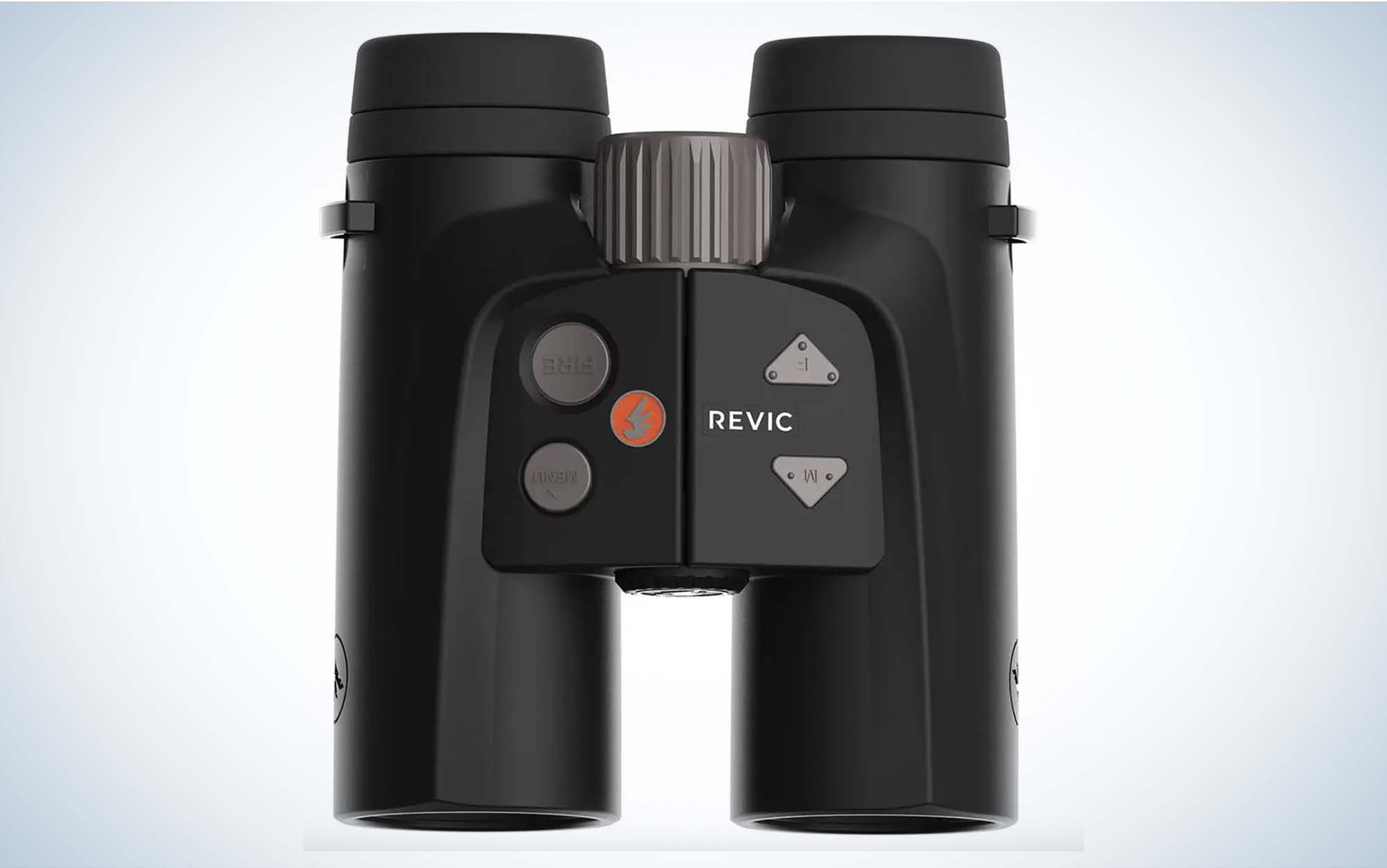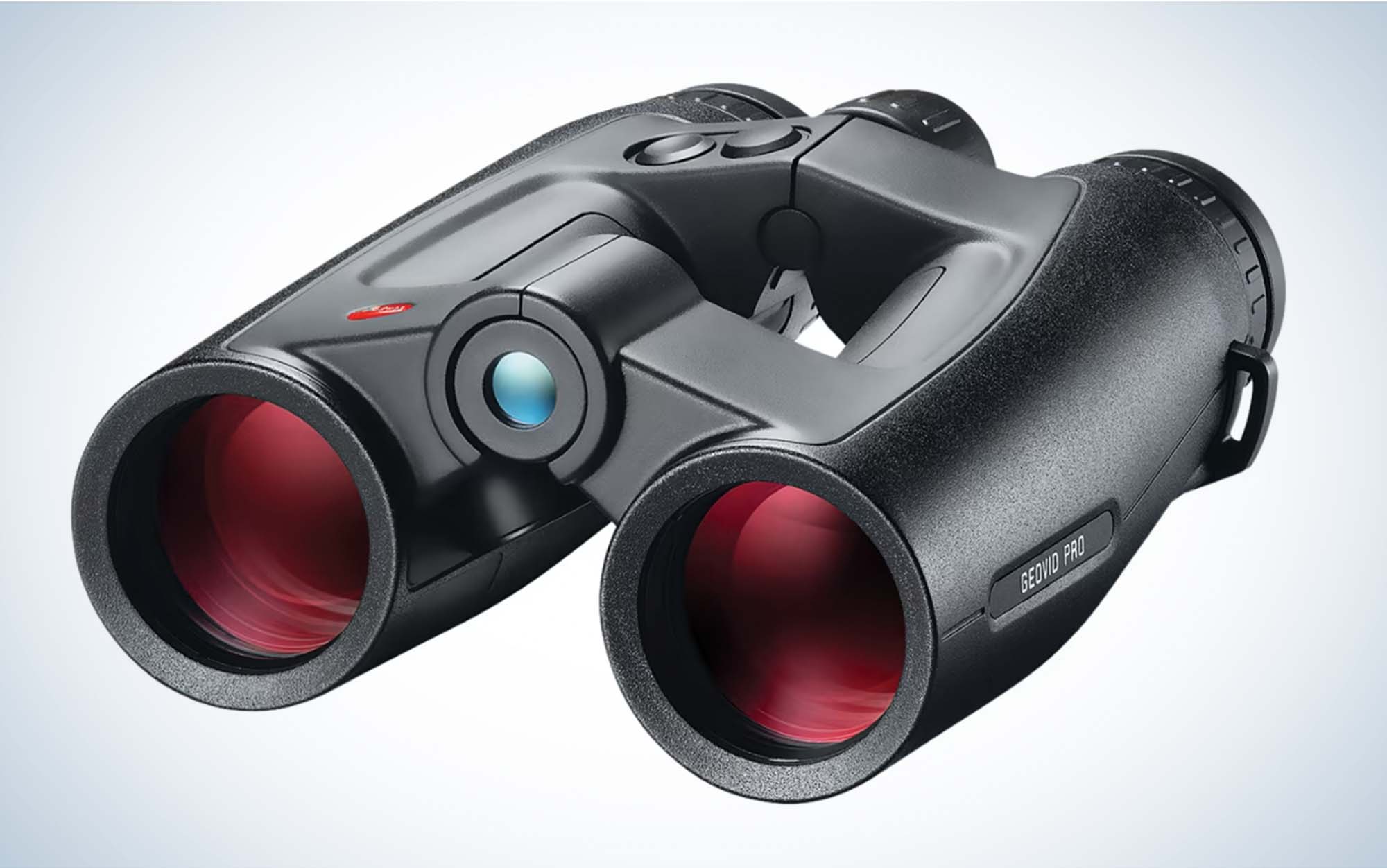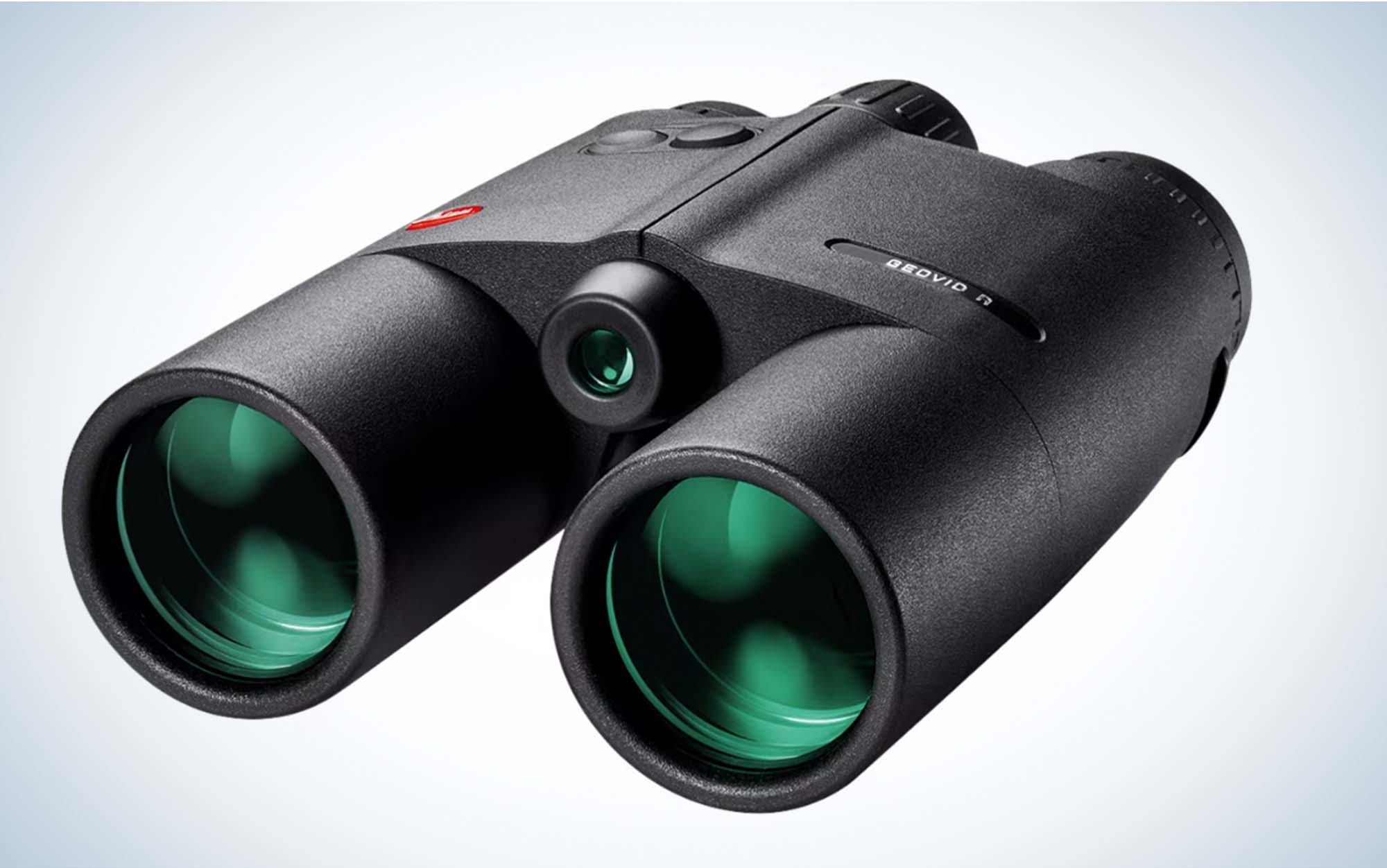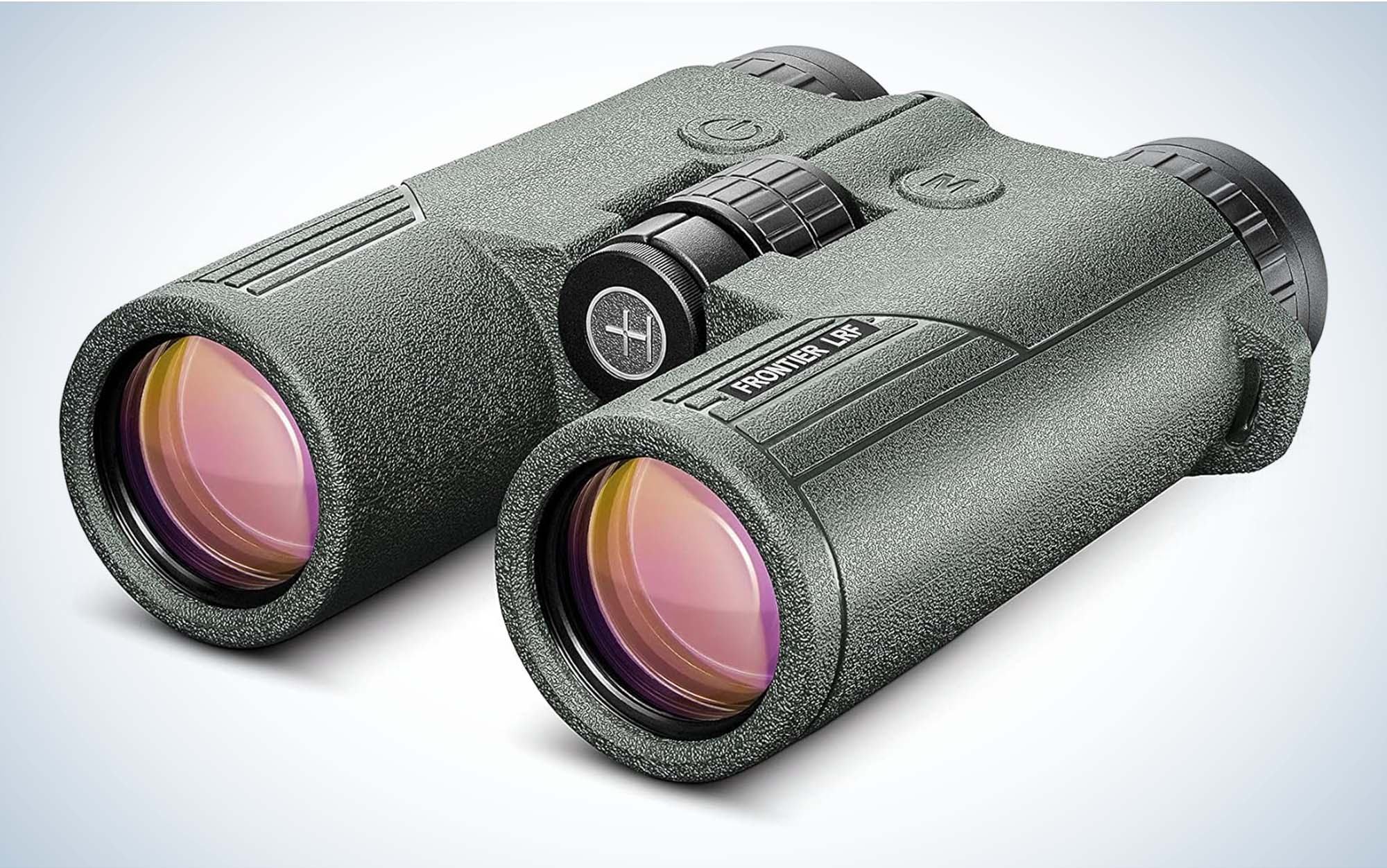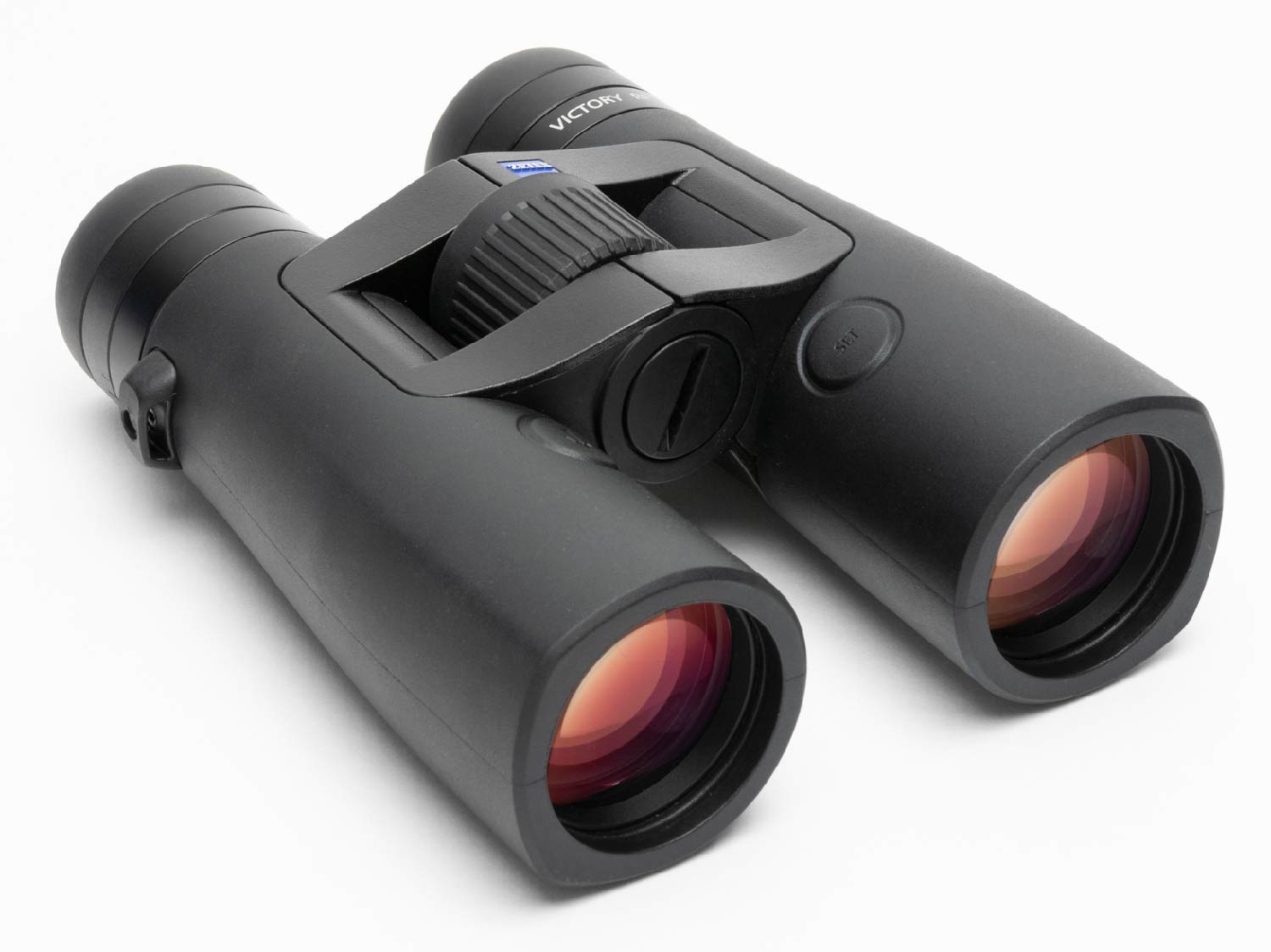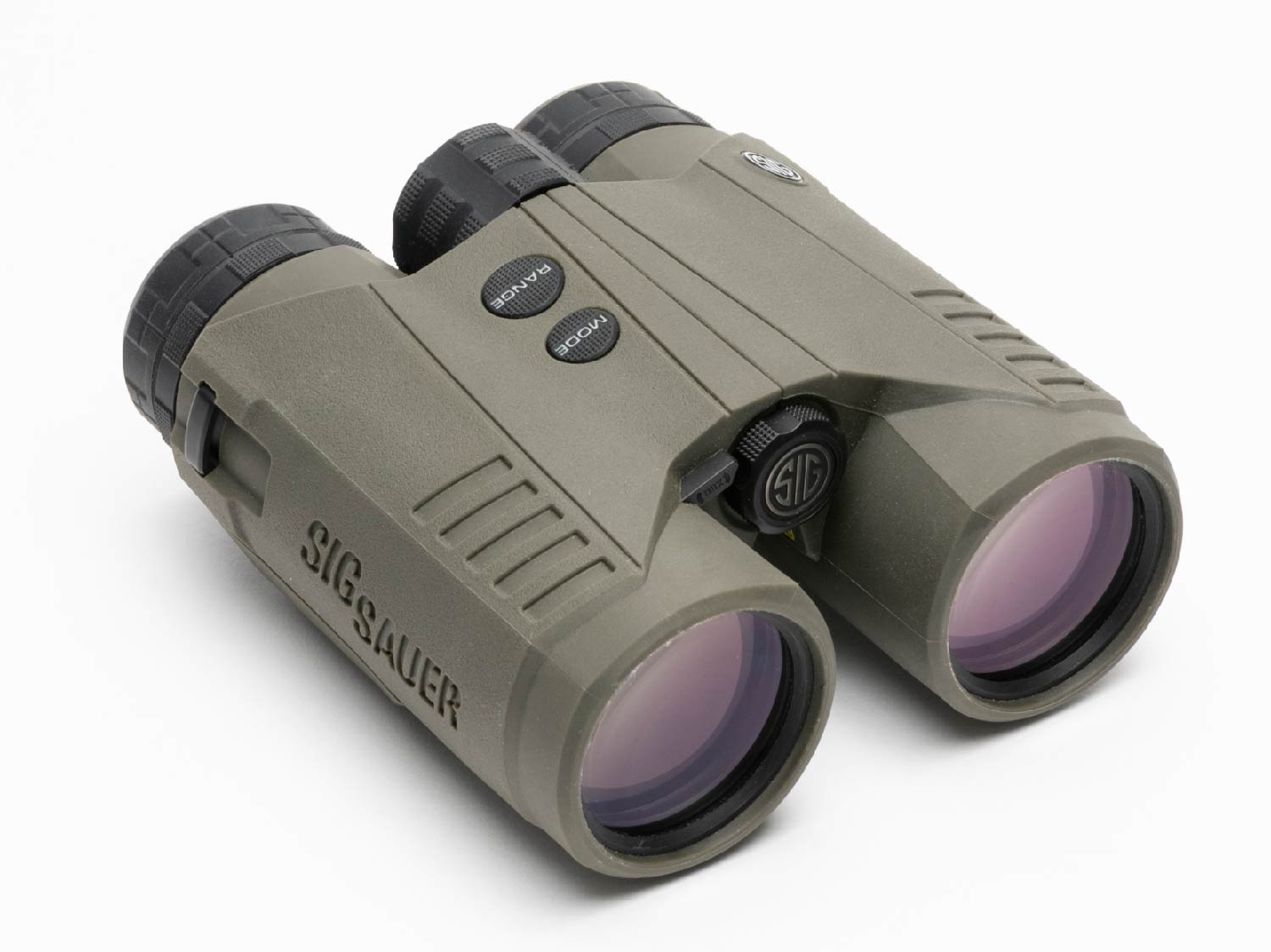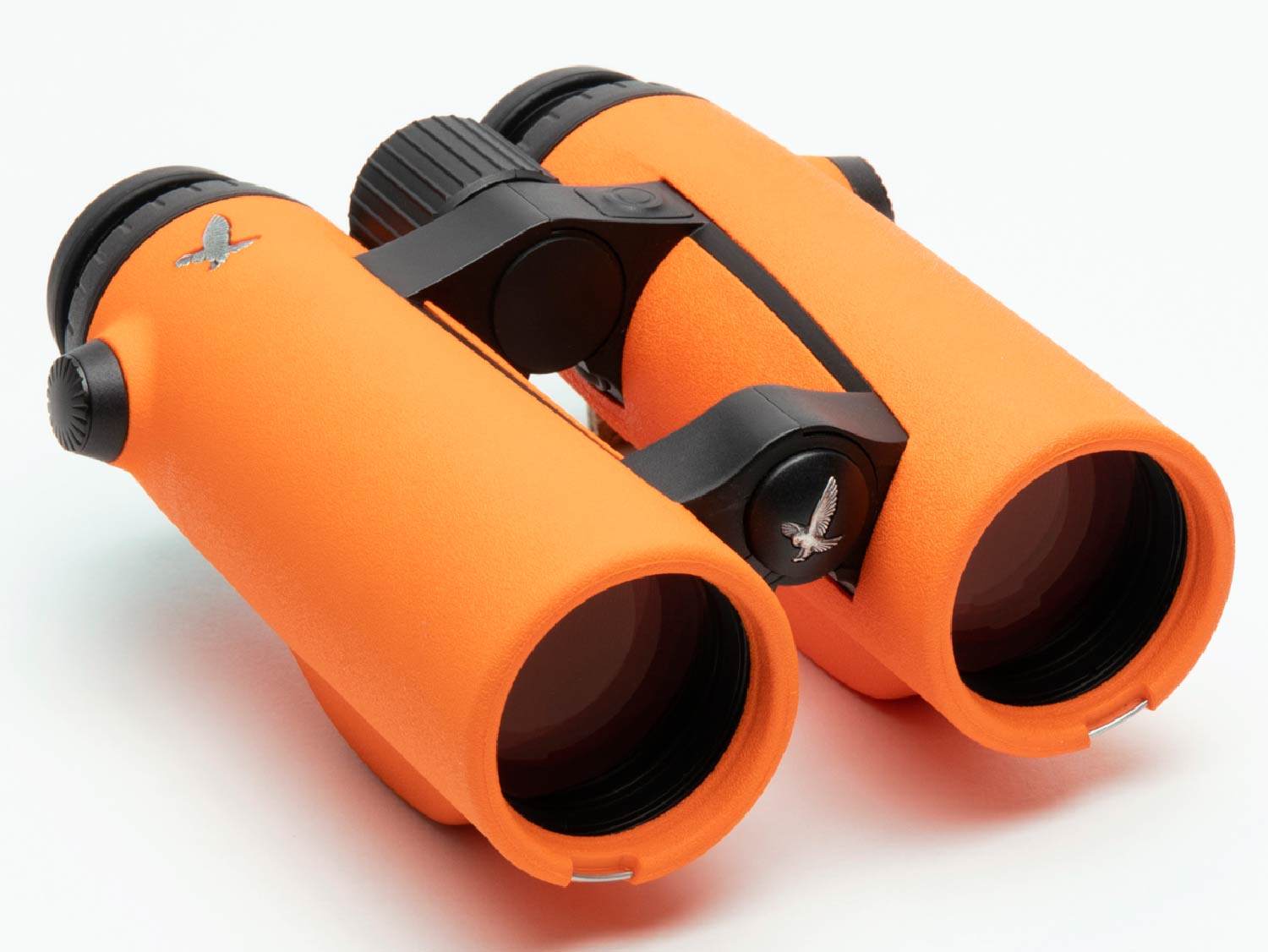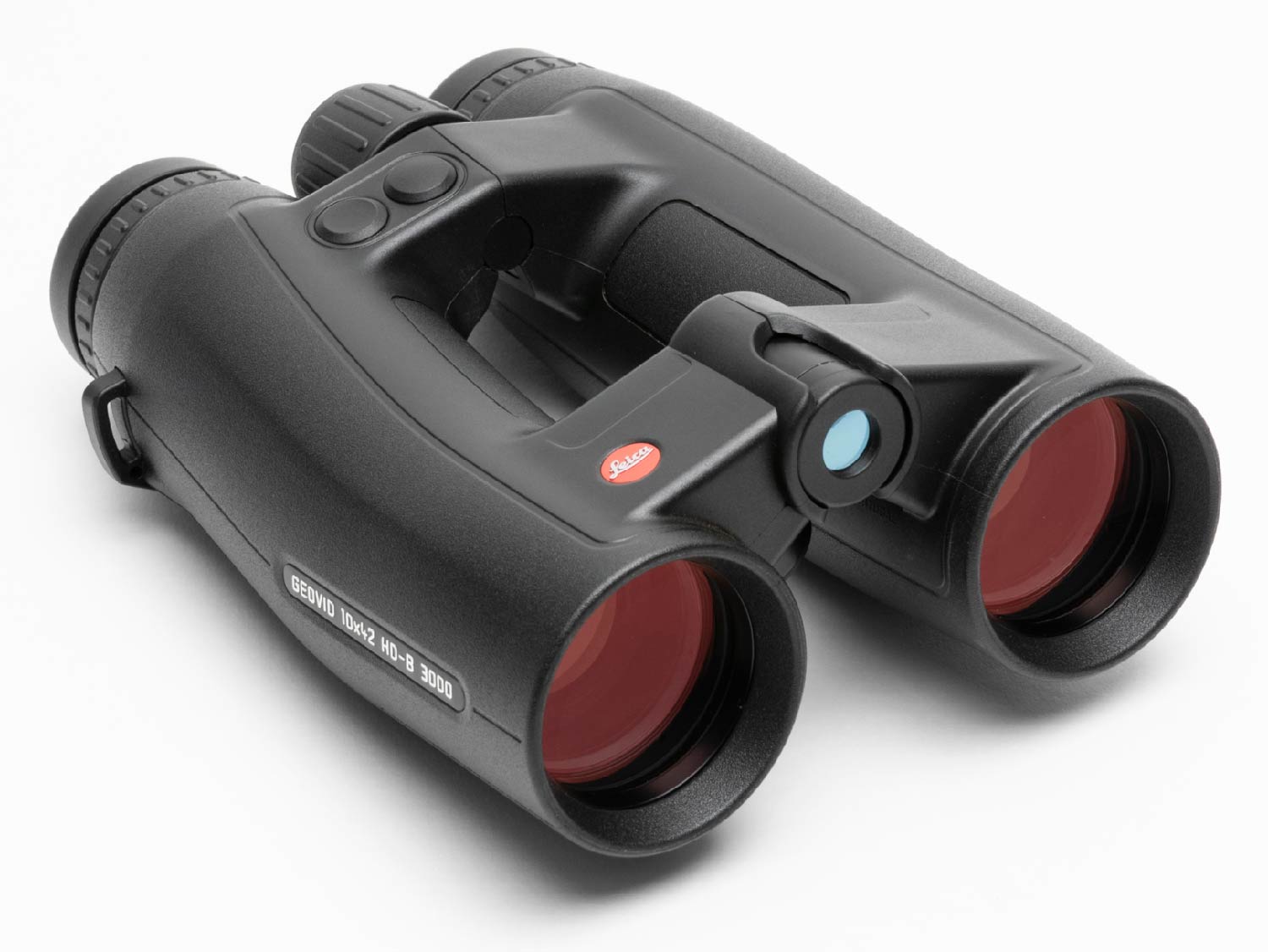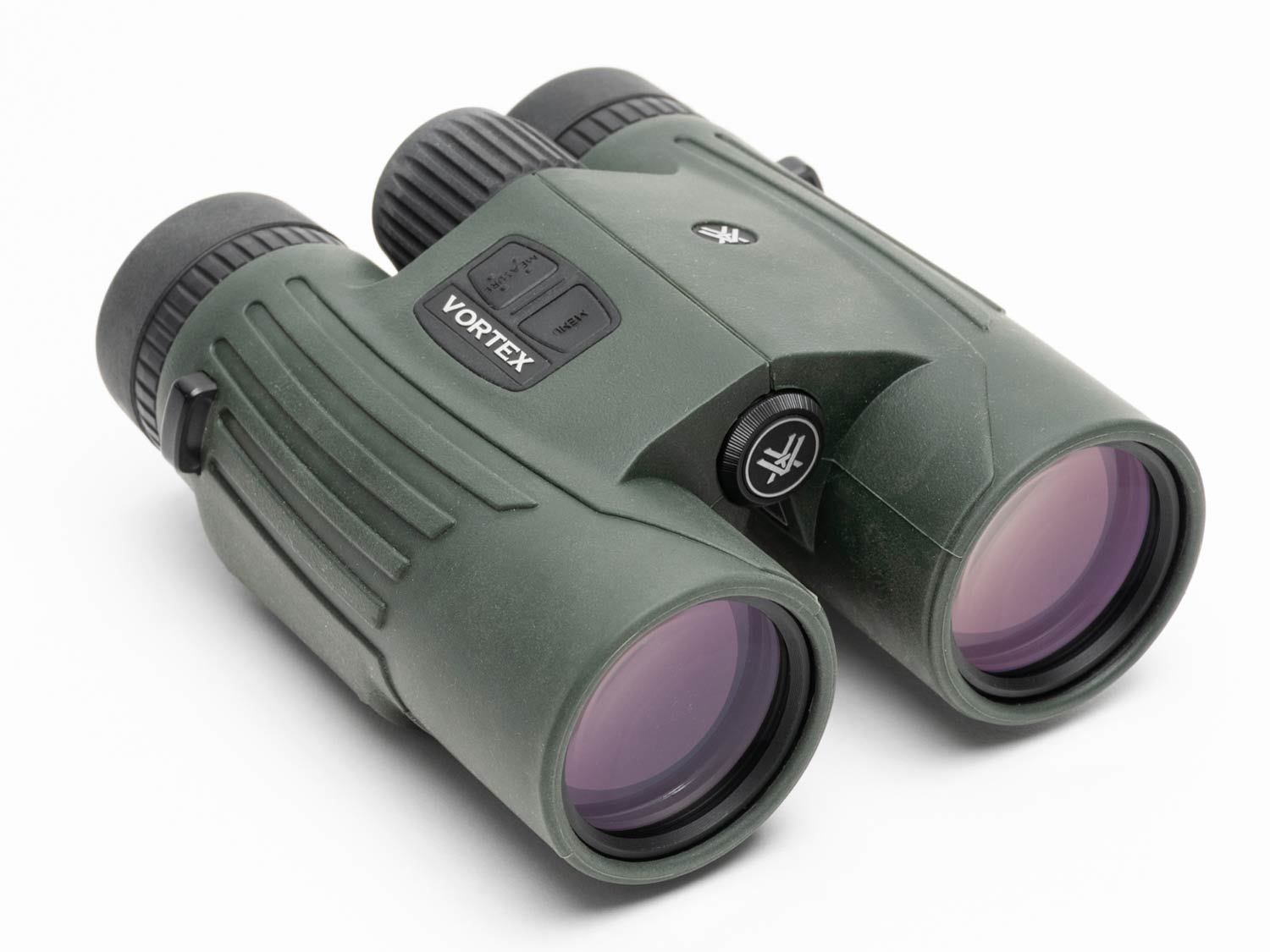Best Rangefinder Binoculars of 2023, Tested and Reviewed
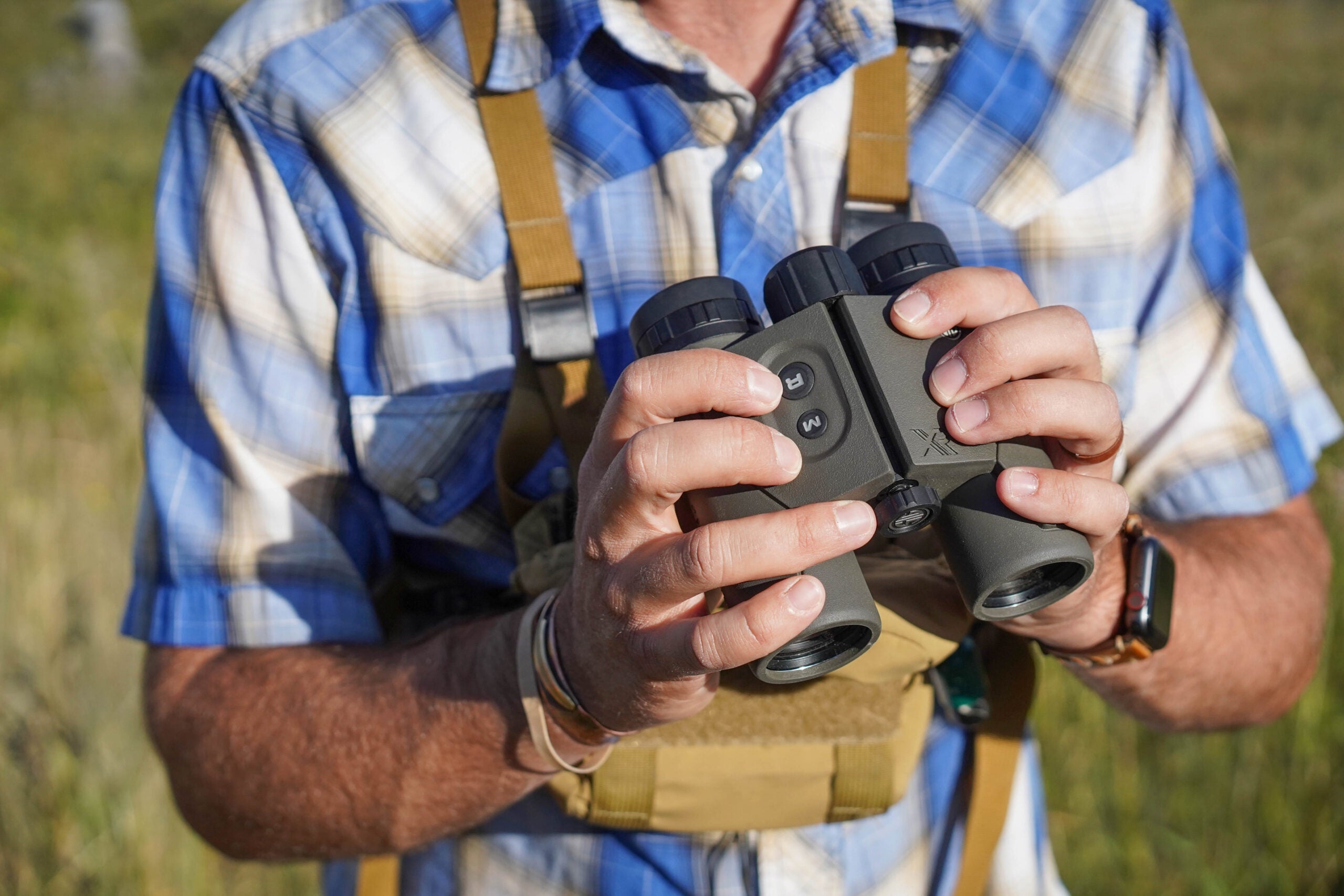
We may earn revenue from the products available on this page and participate in affiliate programs. Learn More ›
Laser rangefinding binoculars answer two essential questions of most hard-core hunters and shooters: What is it? And how far is it?
But the best rangefinder binoculars for 2023 add so much more those the answers. They’re among our most impressive integrations of optics and electronics, with an extra dash of software and real-world durability on the side.
These units can not only render distant details clearly and with enough resolution that you can count antler points or bullseye-target rings, but they also provide aiming solutions, either from on-board software or by connecting to a mobile-phone app that lets shooters customize holds to their specific bullet and ballistics. Some even integrate environmental data, like wind speed and direction, elevation, temperature, and barometric pressure to the shooting solution.
Because this is such an energetic sector of the optics industry, we wanted to test new-for-the-year products against each other, but also against the OGs of the category. So we put out a call for new-model LRF binoculars, but we used three legacy products as the baseline for adequate performance. Those legacy LRF binos are Vortex’s affordable (around $1,100) Fury HD 5000, the venerable EL Range from Swarovski, which retails for around $3,500, and the excellent Zeiss Victory RF, which sells for close to $4,000. If you’re interested in seeing how these three products, all a few years old now, stack up against each other, scroll down to the previously tested LRF binos from 2019.
We undoubtedly missed some solid products for the 2023 edition of our test, and because we did our testing in early August, we probably missed some late introductions. However, our field of seven new rangefinder binoculars covers the landscape from simple to complex, and from the affordable to the expensive.
- Best Overall: Leupold BX-4 Range TBR/W 10×42
- Best Value: Sig Sauer KILO6K 10×32
- Best for Long Range: Revic Acura BLR10b
- Leica Geovid Pro 10×42
- Leica Geovid R 10×42
- Hawke Frontier LRF 8×42
- Burris Signature LRF
How We Tested the Best Rangefinding Binoculars
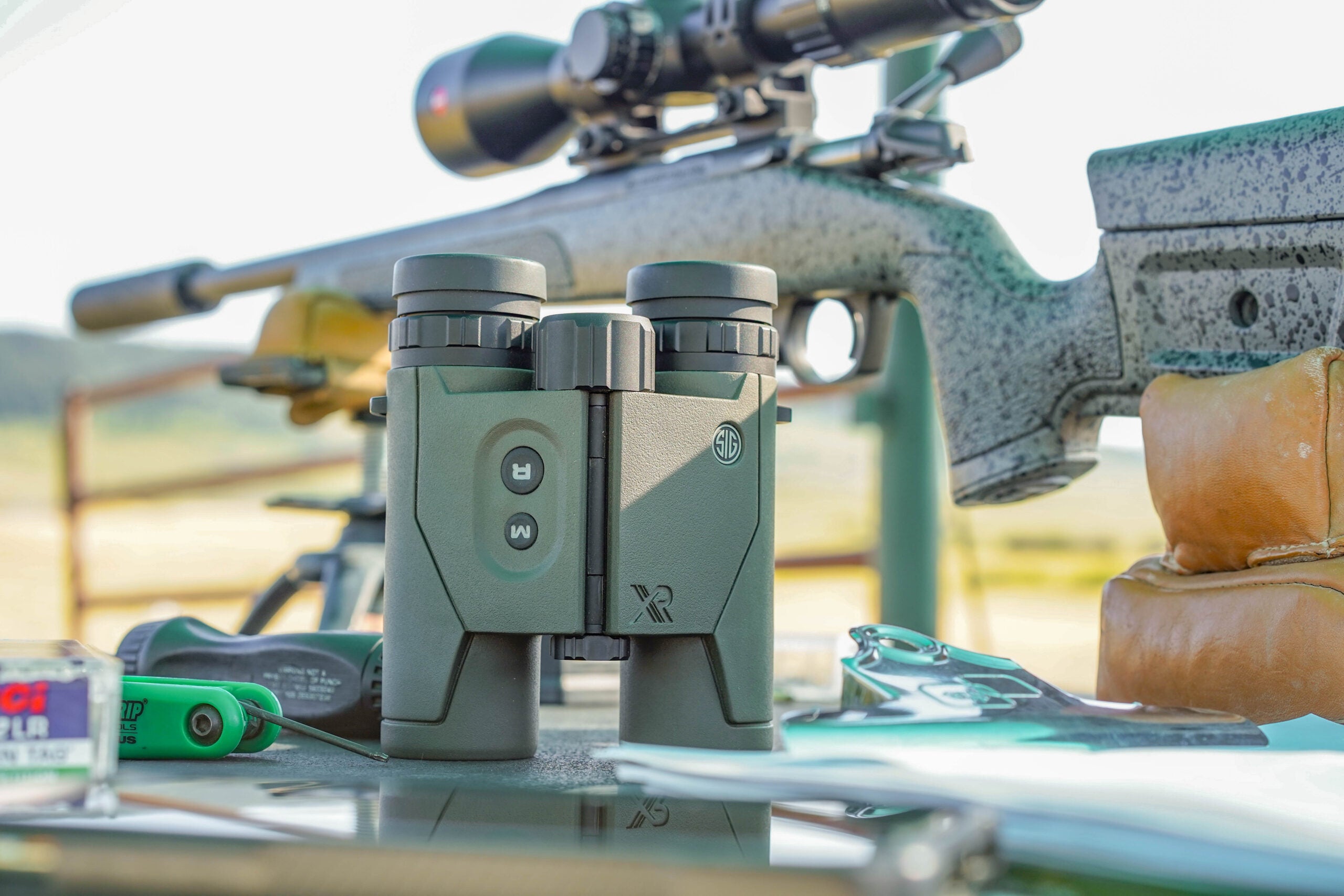
Laser rangefinding binoculars have to pull double duty. Much more so than LRF monoculars, binoculars are intended as optical instruments. They must be able to render distant targets clearly and in all sorts of light conditions. But their ranging capabilities are equally important. Do they deliver fast and consistently precise distances to targets? Can they also inform a shot based on ballistic software, whether on-board the binocular or delivered via connection to a mobile app?
We put all those capabilities to the test in our field evaluations. We measure units’ best far and close distances at targets ranging from barns to grass, trees, and even deer (though occasionally we used Angus cows as surrogates for deer). We assess their target modes, their optical clarity and brightness, and the visibility of the display in changing light conditions and backgrounds. We further determine whether caliber-specific software is intuitive and useful. And we assess units’ price, warranty, and amenities. We test the maximum and minimum range, and use every targeting mode and menu option. We mount binoculars on tripods to get rock-solid ranging, and we take the units in the field, deploying them both methodically and rapidly at targets of various sizes and distances. And then we pair them to a slave rifle and a ballistic app and judge their ability to improve our shooting accuracy.
We break our 10-point scoring into four general categories: ranging performance, display and optics, features, and value. The average of these categories is the basis of our grades, detailed below.
Ranging performance includes both the maximum and minimum distances the unit is capable of ranging, but also ranging precision and ability to repeatedly range objects of various sizes and textures. The performance score also considers various targeting modes. Display and optics assesses how well the unit “sees” targets, how useful and adjustable the display is to each users’ eyesight and different light conditions, and reticle utility. The feature grade assesses whether the unit connects to a mobile app, or contains a ballistic library, or has on-board sensors. Lastly, our value grade is a measure of whether the LRF binocular is worth its price, and considers its peer group, warranty, and amenities like a harness or carrying case.
The laser rangefinding binocular that gets the highest overall score wins our Editor’s Choice award for the best in the category; the optic with the highest price/value score wins our Great Buy recognition. We also assigned other awards for specific noteworthy attributes.
How We Grade Laser Rangefinding Binoculars
Our 10-point evaluation adds up to a total numeric score, but we translate those to grades for each submission. Our Ranging Performance grade combines the scores from ranging, accuracy, sensitivity, and processor speed. Our Display/Optics grade aggregates both display and optical quality scores. The Features grade considers amenities, connectivity, and versatility. And then the Price/Value grade is our value grade, which also considers durability.
To earn an “Excellent” grade, the average of that category must be 9 or higher, which is extremely hard to achieve. “Very Good” is an average score of 7 to 9. A “Good” grade is 5 to 7. Our “Fair” grade is 3 to 25, and “Poor” is anything under 3.
Best Rangefinding Binoculars: Reviews and Recommendations
Best Overall: Leupold BX-4 Range TBR/W 10×42
Leupold
Score Card
- Ranging Performance: Very Good
- Display/Optics: Very Good
- Features: Good
- Price/Value: Good
Key Features
- 10×42
- Durable magnesium alloy chassis
- On-board DNA ranging engine
- Angle-adjusted TBR with wind holds
- Reversible power button
- High-contrast red OLED display
- 2,600-yard maximum distance
Pros
- Simple, functional display
- Fast laser return
- Very good optics
- Tripod mountable
Cons
- Only three display brightness options
- Doesn’t connect to ballistic app
- Bulky
Given the trend to pack as much electronic power into a laser rangefinding binocular as possible, Leupold’s long-awaited entry in the category is relatively primitive. The new BX-4 Range is essentially Leupold’s RX rangefinding monocular repackaged as a very good binocular. It doesn’t have a Bluetooth connection to a ballistics mobile app. It doesn’t contain a compass or GPS transponder that will help you find your way home.
But the BX-4 Range is one of the most capable LRF binoculars in our test, performing basic ranging and aiming tasks with minimum fuss, and delivering excellent optical clarity as an important bonus, since these devices are used primarily for viewing.
The Leupold’s interface is fast and intuitive. Users can choose either the company’s patented TBR/W (it stands for True Ballistic Range and is Leupold’s angle-adjusted mode), bow mode (a shorter-distance angle-adjusted mode), line-of-sight mode, or add a wind hold for longer shots. Further, the unit includes 25 ballistic groups so rifle shooters can match distance-adjusted holds to the bullet dynamics of their loads. That’s about it. The BX-4 Range does not include Leupold’s arrow-flight software, called Flightpath.
The unit will express holds in angle-adjusted ranges, or holdover in either MILs, MOA, or inches/centimeters. We ranged deer-sized targets out to about 1,250 yards, farther than the advertised range, and ranged reflective targets at 2,800 yards. The minimum range we recorded was about 12 yards.
I took a prototype BX-4 Range on a mule deer hunt in Mexico, and experienced the speed and simplicity of the unit in the dense brush of the Sonoran Desert. The 10×42 unit performed on par with Leupold’s non-ranging BX-4 Pro Guide binocular, with very good edge clarity and decent field-of-view, both important features when scanning both tight cover and distant viewscapes for big Sonoran bucks. Shot opportunities are fast and fleeting in the desert, and the BX-4 Range performed admirably in these snap-shot situations. The circular reticle in the Leupold is fast and intuitive, and I found I didn’t have to hunt and peck for ranges.
The ranging engine is lightning fast, on par with units from Sig, which has previously been the undisputed speed champion of this category. Leupold’s TBR software is accurate and proven, and the addition of wind holds gives long-range shooters plenty of tools, though competition shooters will probably want to link to custom ballistics software through a mobile app, which isn’t possible with the BX-4.

We recorded a few demerits, both in the field in Mexico and later during our testing. First, the unit is the size and heft of a brick; it’s an ungraceful handful. The closed-bridge design makes it difficult to use with a single hand, though Leupold has thoughtfully made the button operation ambidextrous. The optical coatings that make the red OLED display pop tend to throw a blue-green veil over images. You get used to it after a bit, but it can be distracting. The display has only three intensity settings; we’d like to see an auto-brightness feature in subsequent models. And testers felt that the unit was overpriced, given the fairly spartan features.
It should be noted that, while many sources will cite this as Leupold’s entry into the LRF binocular category, we tested the brand’s first unit as far back as 2019. This latest entry is manufactured by the Czech brand Meopta, but Leupold has smartly loaded its proprietary software inside an optically superior binocular, bringing both new-world and old-world talents to the shooting and long-range (or at least mid-range) hunting game.
For a fast, capable rangefinder housed in an excellent binocular, and backed by Leupold’s legendary customer service, we conclude that this is an excellent “freshman” effort, and worth the wait for Leupold’s re-entry into this dynamic category.
Best Value: Sig Sauer KILO6K 10×32
Sig Sauer
Score Card
- Ranging Performance: Excellent
- Display/Optics: Very Good
- Features: Good
- Price/Value: Excellent
Key Features
- 10×32
- Red OLED display
- Connects to Sig’s BDX mobile app
- On-board Applied Ballistics database with 8 ballistics groups
- Connects to BaseMap app
- Line-of-sight, angle-modified, extended-range, and fog modes
- On-board temperature and altitude sensors
Pros
- At about $1,100, attractively priced
- Exceptional range, out to 2,500 yards on deer
- Very fast laser return
- Connects to BDX app for long-range aiming solutions
- Available in 10-power and 8-power versions
Cons
- Disappointing low-light performance
- Operation slows when connected to external sources
- HyperScan mode drains battery
You may be attracted to this exceptional rangefinding binocular by the price, but you should appreciate its abundant features, especially if you’re an archery or whitetail hunter looking for a great deal on a mid-range model.
Its compact 32mm frame makes it a natural choice for tight-quarters hunting in a treestand or ground blind, and it easily handles with a single hand. A free firmware update gives you Sig’s Archery Mode, which compensates for extreme angles at the distances bowhunters regularly encounter.
But the Sig’s diminutive size—it’s also available in a 10×42 version—shouldn’t fool you. There’s a ton of both optical and ballistic horsepower in this 26-ounce, 5-inch marvel.
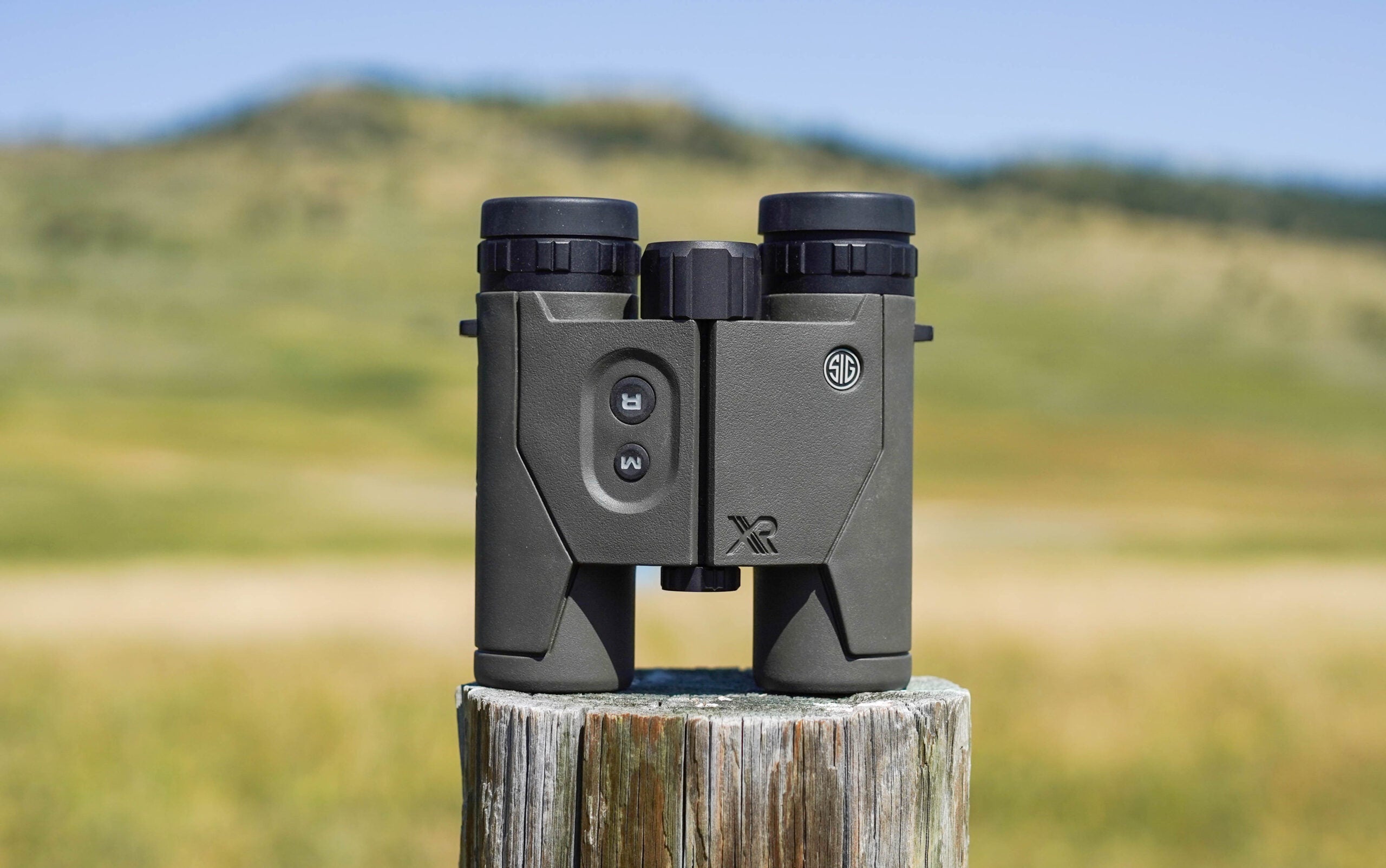
For starters, the KILO6K connects to Sig’s excellent BDX app, and tethers to BDX-compatible riflescopes and LRF monoculars. Under the hood of the 10×32 binocular, the unit carries Applied Ballistics Ultralite software, which delivers bullet-specific ranges out to 800 yards. And when connected to an external device, the unit can run on AP Xtended Range, which provides range-adjusted holds out as far as you can shoot. The unit also connects to the BaseMaps app, which is useful for dropping location-specific waypoints. The KILO6K has a programmable display and pairs with Garmin and Kestrel environmental sensors.
So much for its brains. How about its brawn? Every tester noted a distracting blue distortion, evidence of optical coatings designed to boost the red OLED display. In terms of ranging acumen, we were able to get about half the stated value on a variety of targets in bright sunlight; we fared a little better in low-light conditions. Some testers wanted a configurable reticle, noting that the circle is overly large and takes up too much of the field of view on distant targets.
The Sig ships with one of the best harnesses in our collection, and every tester noted the tremendous value they deliver for about $1,100.
“As a [precision rimfire] match director, I found this to be an extremely useful unit when connected to the BaseMaps app,” noted Gibson. “I can quickly plan where to place targets and have the distances easily added to my match book.”
With the addition of Sig’s Archery Mode software, the handy size, and the huge amount of both optical and ballistic capability in the diminutive binocular, this is possibly the perfect laser rangefinding binocular for archery, whitetail hunters, and target shooters who don’t intend to engage targets beyond about 2,000 yards. It’s the overwhelming pick for our Great Buy award, and came very close to taking our Editor’s Choice award, as well as the test’s top rangefinding binocular.
Read Next: Best Binoculars for Hunting
Best for Long Range: Revic Acura BLR10b
Revic
Score Card
- Ranging Performance: Very Good
- Display/Optics: Good
- Features: Very Good
- Price/Value: Good
Key Features
- 10×42
- Just 5.2 inches tall
- Reports holds in MOA, MIL, and “Shoot-to-Range” matched to ballistic turrets
- On-board or custom wind holds
- 5,000-yard range on reflective targets
Pros
- Configured for long-range shooters and hunters
- Bluetooth connectivity to Revic Ops ballistic app
- Base and vector wind modes offer next-level horizontal holds
- Very good optics
- Useful “Quick Keys” navigation
- Auto display brightness
- Ships in distinctive foam case, with useful field cover
Cons
- Complicated interface
- May be too much inputs for casual shooters/hunters
- At $2,700, a pricey unit
There’s a new player in the long-range shooting and hunting game. Revic, the optics arm of the long-range rifle company Gunwerks, has come out with a rangefinding binocular that packages all the excellent ballistics capability of its LRF monocular in a sharp and useful field optic. The Acura BLR10b allows shooters to connect via Bluetooth to the Revic Ops app, or to use on-board ballistics and wind solutions to make shots at truly impressive distances in challenging conditions.
The Revic does so many things so well that it lost to the excellent Leupold by a single point for our best rangefinding binocular award. Because it’s configured so purposefully for long-range shooting, it gets our nod for the best long-ranger of the test. And it’s a unit you should consider as you look at the other ballistically superior LRF binoculars on the market: Sig’s exceptional KILO10K, Leica’s Geovid Pro, and the Vortex Fury 5000 AB.
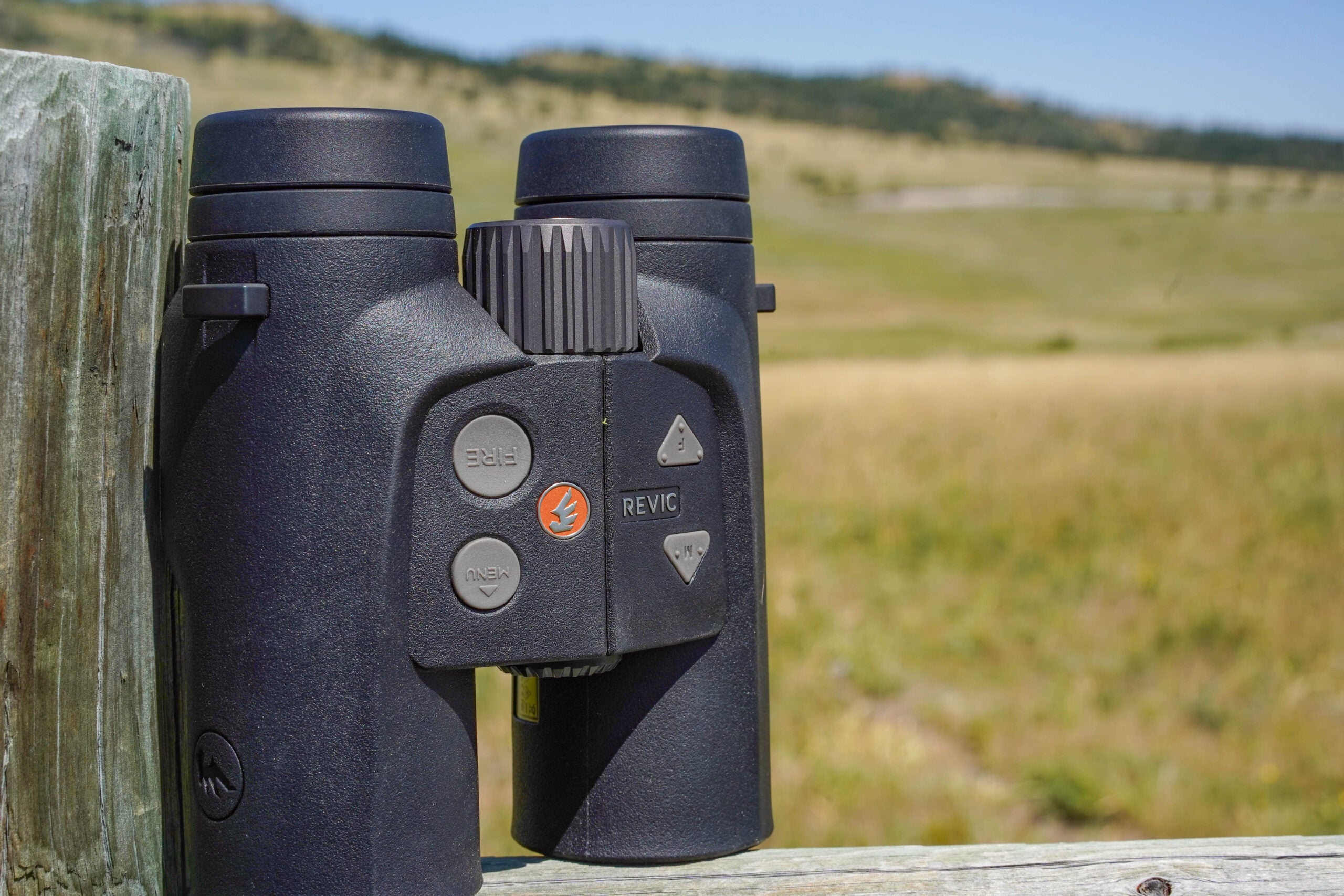
On the basis of measurable attributes, the ranging sensitivity of the Revic Acura is on par with those of Sig and Leupold, which is to say excellent, though testers noted that the Revic’s speed is noticeably slower than its peers. Its glass is a touch better than the Leupold’s, as measured by our resolution and low-light assessments. And its interface with the excellent Revic Ops ballistic app is very good.
Among the attributes that elevated the Acura: its twin wind modes, its three holdover notations, and its ability to connect to an external Kestrel or Garmin without slowing down its processor. That last attribute is worth dwelling on. Many rangefinders operate at lightning speed when deploying on-board ballistics software, but tend to run slower and drain batteries when connected to an external device. The Revic slowed slightly when we connected it to both the mobile app and a Kestrel meter, but not tragically.
Tester Kyle Gibson noted the easy exchange of information between the Revic Ops app and the Acura unit.
“I was impressed with how quickly and easily I was able to build different [ballistic] profiles in the app and move them to the LRF,” Gibson noted.
The wind notations are useful. Use either the on-board wind inputs for horizontal range-adjusted holdoff values, or input a vector wind to get the full suite of wind holds, including spin drift, aerodynamic jump, and Coriolis effect. Holdovers are delivered in either MIL, MOA, or Revic’s own “Shoot-to-Range” hold that informs dial values for a ballistic turret to deliver a bullet at a specific range.
We also liked the ergonomics of the compact, short, and lithe unit. And for testers who have priced the Revic’s peers, the $2,700 price tag is a relative bargain for the ballistic and optical horsepower it delivers.
The unit lost points in ranging distance; on our test field we couldn’t quite get half its stated value of 5,000 yards. And some testers complained about sluggish returns, including a full second delay for some distant readings.
“Seems like this is a unit that’s made for a very specific use case,” wrote one tester. “Overall good and limited use, but glass is not better than the Leica [Geovid Pro] and is much slower than the Sig.”
We noticed some edge distortion and low-light performance was in the middle of the pack. Some testers had trouble with erratic auto-intensity settings on the display. But those are fairly minor quibbles that don’t degrade the Acura’s main job, which is to get long-range shooters on target quickly and confidently. And for a fair price, considering its prodigious talents.
Read Next: Best Binocular Harnesses
Leica Geovid Pro 10×42
Leica
Score Card
- Ranging Performance: Very Good
- Display/Optics: Excellent
- Features: Good
- Price/Value: Good
Key Features
- 10×42
- Excellent optics
- On-board Applied Ballistics UL software
- Line-of-sight, angle-adjusted, and holdover-corrected modes
- Class-leading field of view
Pros
- Open-bridge design easy to use with one hand
- Sub-10-yard close range
- Connects to Kestrel weather meter
- On-board atmospheric sensors
- Connects to BaseMaps app or Google Maps for location data
Cons
- No scan mode
- Ponderously large and heavy
- At $3,300, a pricey unit
- Not easily tripod mountable
It’s interesting that Leica led with the sized-down 10×32 version of this excellent rangefinding binocular. The smaller version of the Geovid Pro wowed our test team last year, and in some ways we wish Leica had stopped there. The 10×32 Geovid Pro remains a high-water mark for a rangefinding binocular’s optical and ballistic capabilities.
With the 10×42 version of the model, introduced earlier this year, Leica has added some optical horsepower—the larger objective lens adds about 10 minutes to effective viewing in early morning and in late evening thanks to its better light transmission. But with its larger lenses and overall dimensions, it’s given up the ergonomics and field-worthy capabilities of the smaller version.
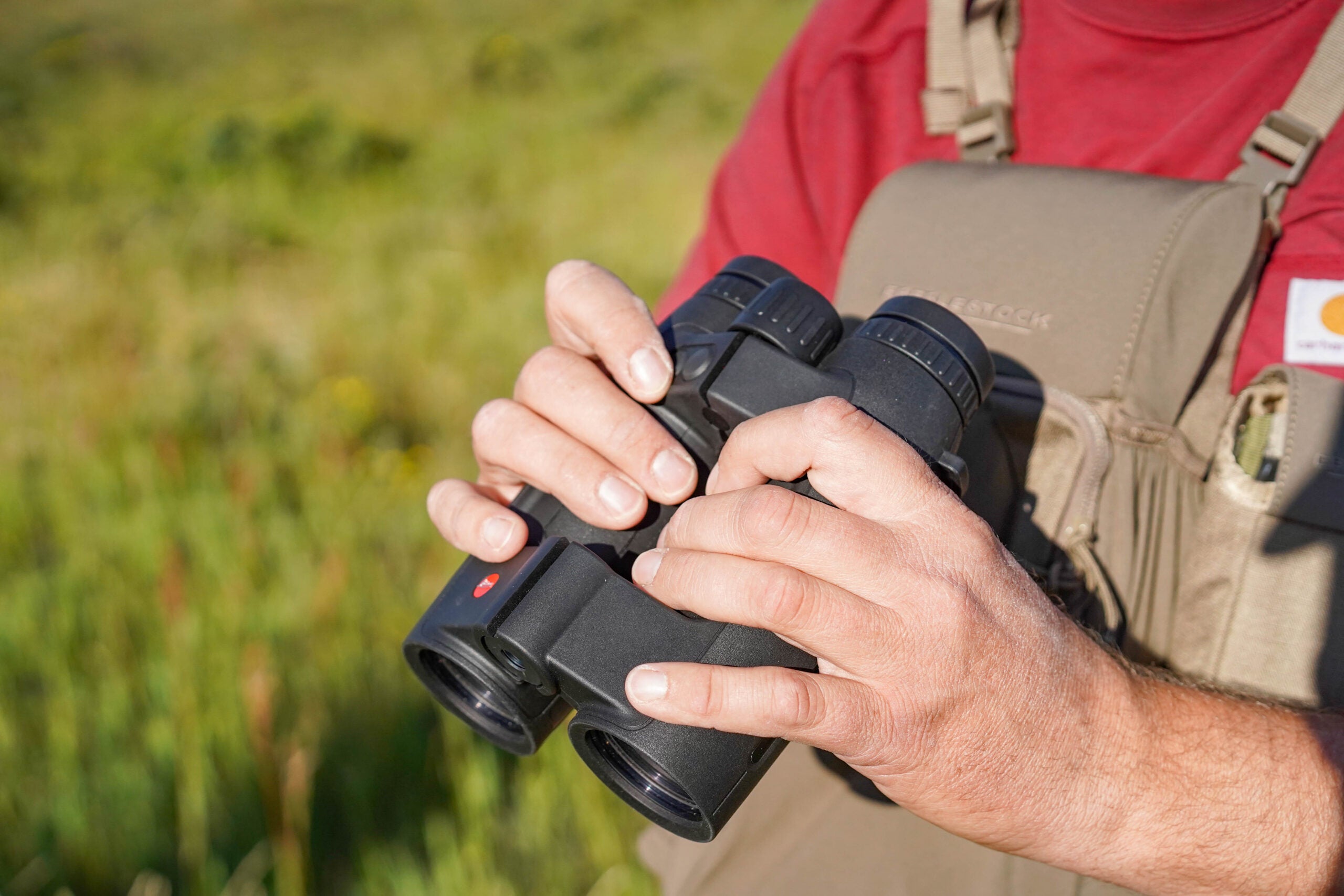
The new Geovid Pro is an optical marvel. It easily won our low-light and resolution tests, and for users who mainly want a very good binocular, it’s our consensus pick as the optics of our test. The open-bridge design allows for fair handling, but users longed for the quick deployment of the smaller Geovid Pro.
“This 10×42 version feels like a battleship, compared to the speed-boat action of the 10×32,” said one tester. That’s a fair assessment, though we also noted that the 10×42 version is better suited to long-range competitions and many Western big-game hunting scenarios which rely on optical resolution.
Like its little brother, the 10×42 is loaded with Applied Ballistics Ultralite software, which provides adjusted aiming solutions out to 800 yards. If you want to go farther, connect to Leica’s app for custom holds out to 2,000 yards, which derives aiming solutions from Applied Ballistics Xtended Range version. It’s for those long targets that users will appreciate the fine optics of the 10×42 model. One of the value propositions for the Leica is its tracking capability. Say you shoot a deer across a canyon. You can range the spot of the target, drop a waypoint, and then connect to a mapping app to have that specific shot captured, allowing you to walk to the spot of the shot, but then to track the animal across the landscape. It’s a useful feature, though we had trouble with the stability of the connection between binocular and mobile app.
From a ranging perspective, testers appreciated the fast read of initial targets, but universally noted the slow reset of the ranging engine. Many wanted a scan mode to confirm distance of frustratingly slow or moving targets, and others noted the spendy price for a unit. But the Leica has the best optics of the test, and it’s worth noting that the optically excellent 10×42 Ultravid binocular sells for only about $1,000 less than the Geovid, and delivers none of the ballistic intelligence of the LRF binocular.
Leica Geovid R 10×42
Leica
Score Card
- Ranging Performance: Good
- Display/Optics: Good
- Features: Good
- Price/Value: Good
Key Features
- 10×42
- Basic rangefinder
- Scan and angle-adjusted modes
- Excellent optics
- About 2 pounds
Pros
- Simple operation
- 10-yard minimum range
- 2,000-yard maximum range
- Real-world ranging very close to advertised
Cons
- No ballistic modes
- Slow reset
- Sloppy focus wheel
For those hunters and shooters who want an optically superior binocular but only a minimalist rangefinder, this is the unit for you. The Geovid R brings Leica’s excellent glass and coatings to the game along with a rangefinder that will tell you the dead-level distance to your target, but that’s about it. It doesn’t have any ballistic functions, angle-adjusted ranging, or even targeting modes.
What’s very interesting about this unit, and the detail that sets it apart from Leica’s fully featured Geovid Pro, is that it doesn’t pretend to be more than it is. This is essentially Leica’s mid-level Trinovid binocular with a bare-bones rangefinder worked into its architecture. The price, around $1,400, is on par with the price of the Hawke and Burris laser rangefinding binoculars in our test, but the Leica brings way more optical performance to the game, even if its rangefinding talents are a little flat.
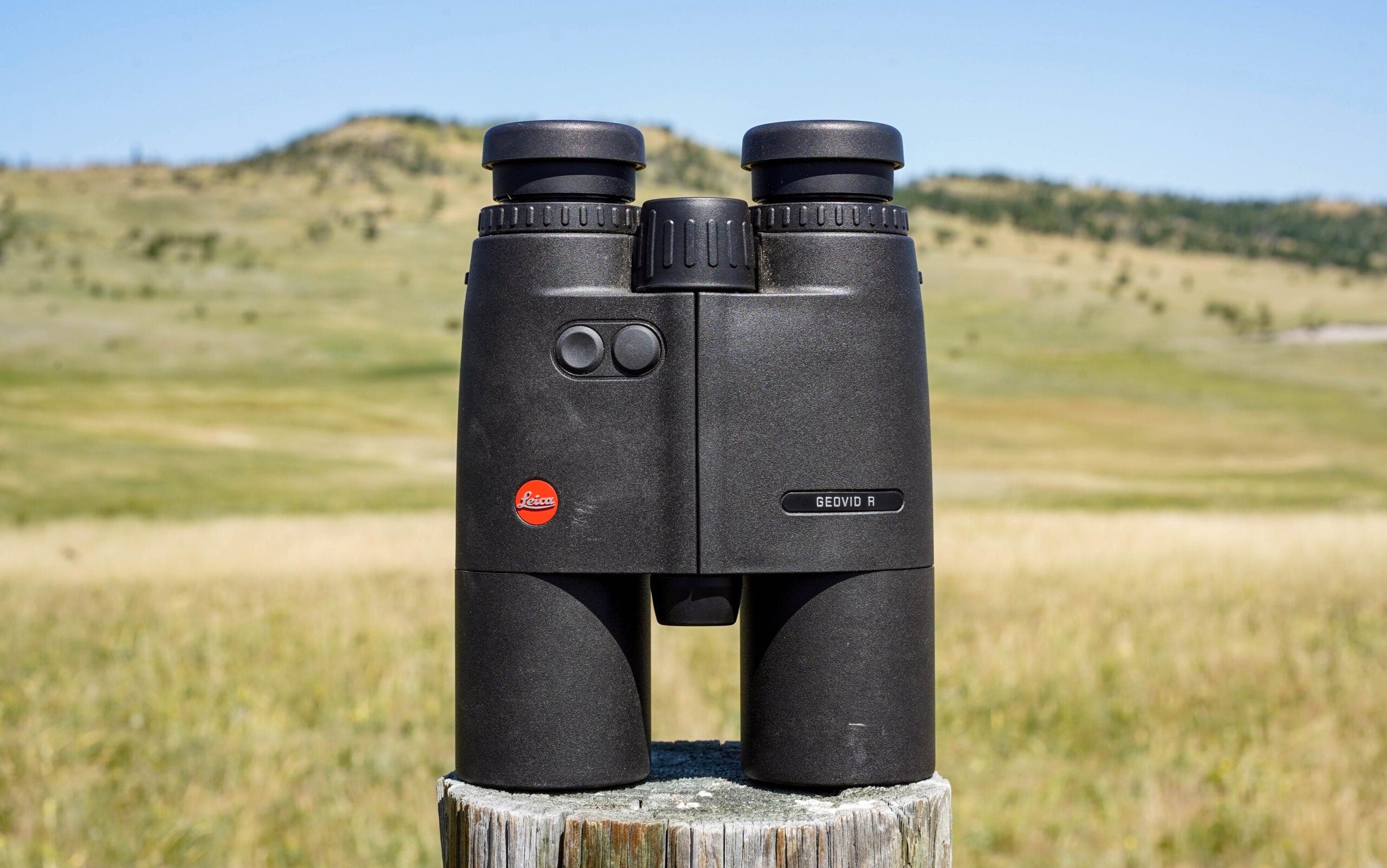
Let’s talk about that rangefinding. The Geovid R gives you line-of-sight ranging at targets from about 10 yards, which we confirmed, out to about 1,800 yards, a little bit shy of the 2,000-yard advertised range. The red LED display is crisp and handy, and the ranging and mode buttons are easy to reach and to navigate.
But that’s the extent of the Geovid R’s ranging capabilities. Instead, this is a unit that leads with optical performance. It finished near the top of the field in both optical resolution and low-light performance, and testers noted its fine edge clarity and overall brightness, especially compared with peers that have such heavy optical coatings that images can appear washed out.
But testers also noted with concern the pedestrian ranging.
“It took forever to get from angle to distance modes,” noted tester Luke Cocolli. “Overall, the electronics seemed glacial compared with other units in our test.”
Testers noted the sloppy focus wheel but applauded the locking eyecups. Overall, the Leica Geovid R was a mild hit with testers, who noted that it’s the best of the optics-first rangefinders in our evaluation, and a very good value at about $1,400, given that it brings basic rangefinding to the viewing equation.
Hawke Frontier LRF 8×42
Hawke
Score Card
- Ranging Performance: Very Good
- Display/Optics: Good
- Features: Fair
- Price/Value: Fair
Key Features
- 8×42
- 11-1,200-yard stated range
- Distance, Rain, Hunt, Near target modes
- Line-of-sight and angled modes
- 6-step red LED display
- Magnesium chassis
Pros
- Ships with premium harness
- Tested distance exceeded advertised distance
- Informative heads-up display
- Decent return speed
Cons
- Underwhelming optics
- No connection to ballistic software
- Fairly pricey for limited feature set
Along with the Burris and the Leica Geovid R, the Hawke is one of a line of bare-bones rangefinders conjoined with a fairly capable binocular. But, in the case of the Hawke, the rangefinder’s performance exceeded our expectations while the optical performance disappointed testers.
Let’s start with the rangefinder. Hawke advertises that the unit will stretch from 11 out to 1,200 yards, but we managed readings as close as 6 yards and way out to 1,970 yards, making us question the modesty of the advertised range. We also liked the repeatability of the rangefinder, and the precision, especially given the oversized circular reticle.
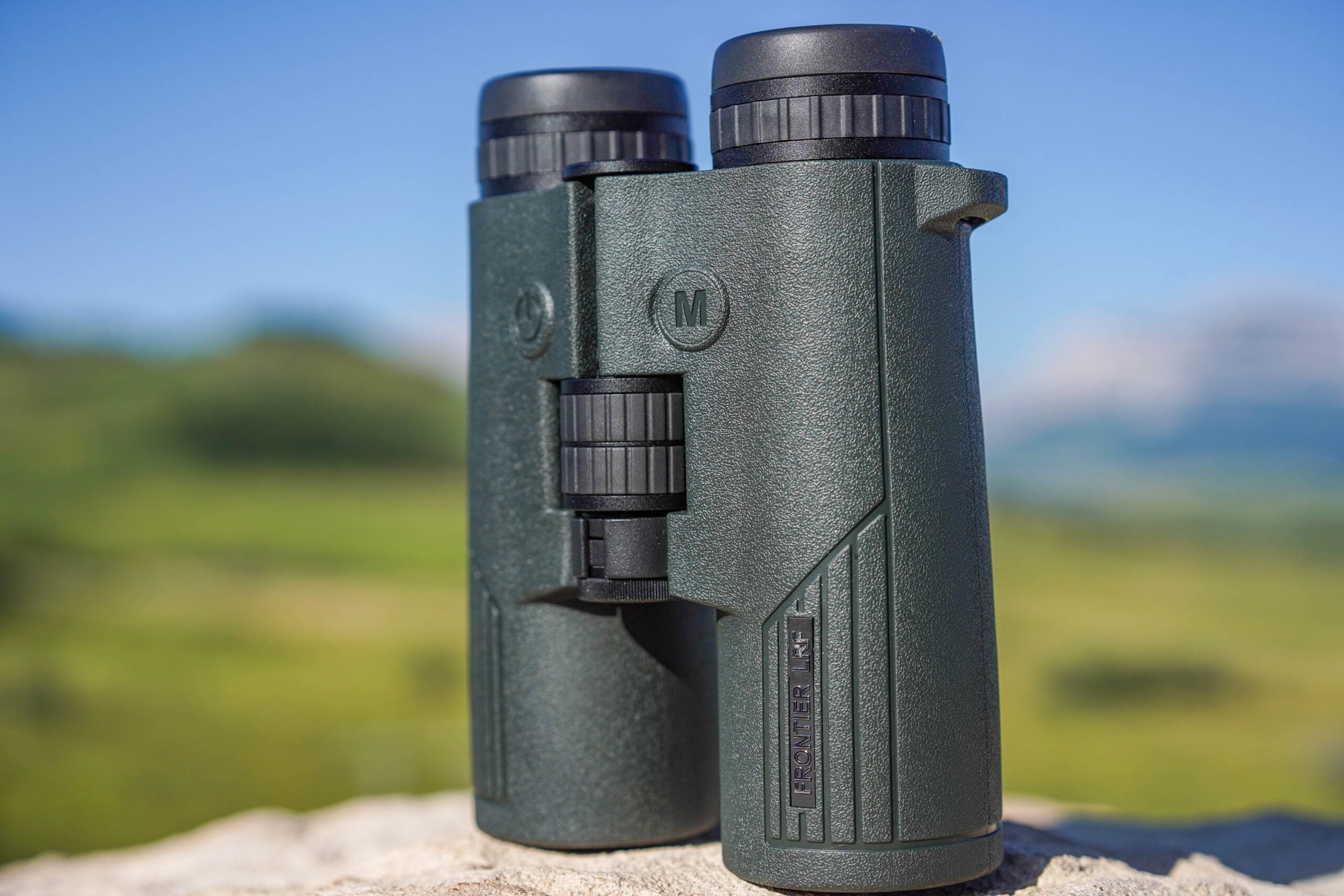
The ranging speed was on par with our expectations, and the modes—the Frontier LRF includes last-target, near-target, fog, and hunt modes as well as both angle-adjusted and line-of-sight ranging modes—are what we’d expect for the type and price of unit. In this regard, it has all a hunter or shooter engaging targets at moderate distances needs. It doesn’t connect to a ballistic app or have any on-board ballistics software.
The Hawke ships with a very good chest harness, and the binocular—which is also available in a 10×42 version—is covered by one of the best warranties in the category.
But that’s about the extent of the atta-boys. Optically, the Frontier LRF falls short. The unit finished near the bottom of our resolution and low-light assessments, and testers noted a good deal of peripheral blurring and washed out images in bright sunlight. Nearly every tester recorded eye strain, which limits the amount of time this LRF will be used in real-world conditions.
Overall, testers felt the Hawke was overpriced by a couple hundred dollars, but appreciated the full-featured rangefinder, especially compared with more optics-forward units like the Leica Geovid R.
Burris Signature LRF
Burris
Score Card
- Ranging Performance: Good
- Display/Optics: Good
- Features: Fair
- Price/Value: Fair
Key Features
- 10×42
- Three ranging modes: auto, sport, hunt
- Line-of-sight and angle-adjusted ranging
- Scan mode
Pros
- Ships with stitched field case
- Tripod mountable
- Intuitive menu navigation
- Oversized focus wheel
Cons
- No connection to ballistic software
- Overly large reticle
Call this a point-and-shoot laser rangefinding binocular. Like the Hawke and the Leica Geovid R, there are not a lot of bells or whistles to this unit from Burris, the first rangefinding binocular from the brand. You get all the modes (auto, sport, and hunt) and targeting (angle-adjusted and line-of-sight) that you might get with Burris’s LRF monocular, but you get the added benefit of both-eyes viewing and the stability of a both-hands binocular.
For Burris’s first foray into the category, the Signature LRF brings some noteworthy talent. Our testers reported very fast range readings and a bright display that had to be manually dimmed in low-light situations. Optically, the unit was a bit disappointing. Testers reported peripheral blurring and a washed-out image in most light conditions. The Burris finished dead last in our low-light rankings.
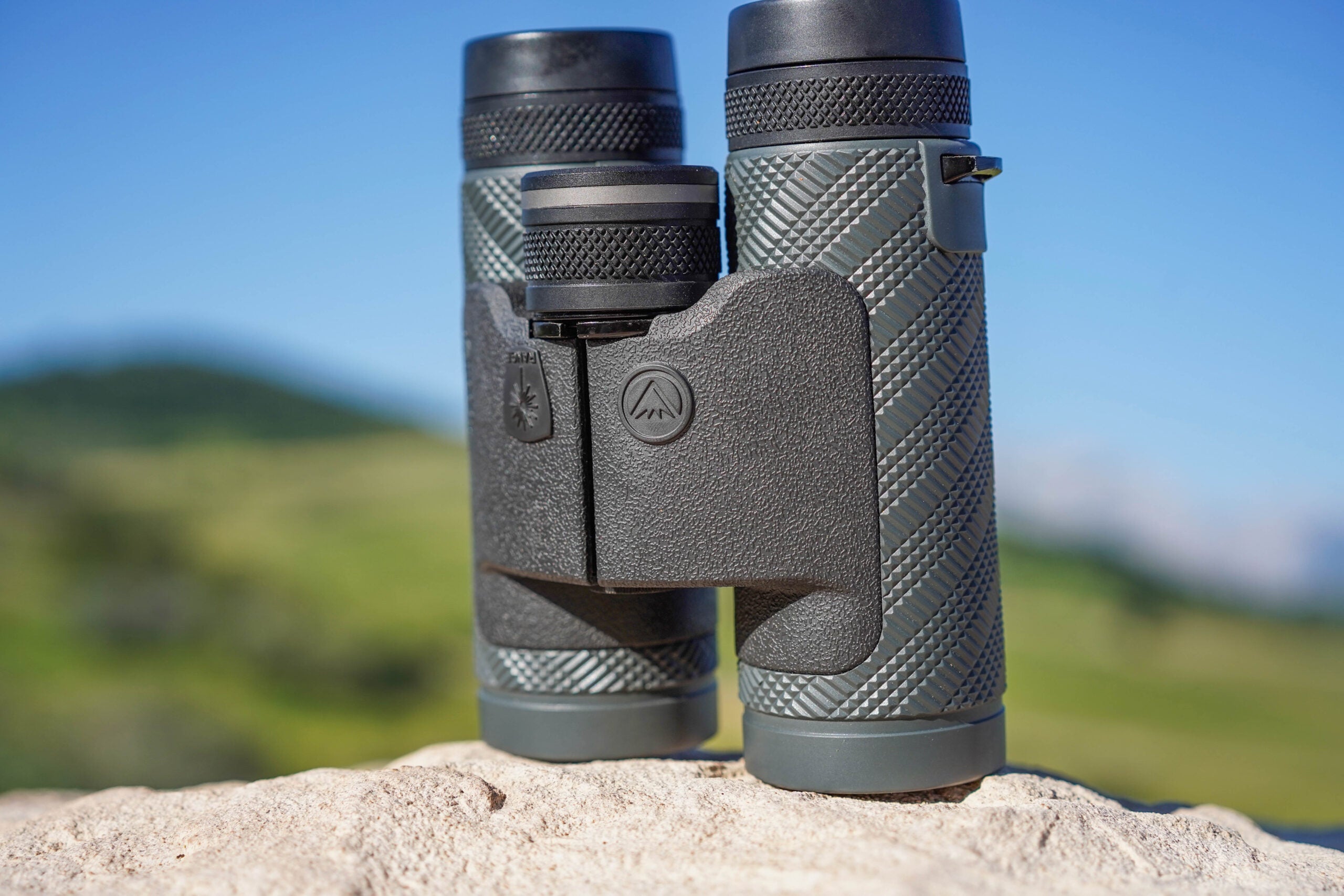
Electronically, the Burris performed almost exactly as advertised, though we weren’t able to achieve the 2,600-yard stated range. Our maximum distance was about 1,400 yards, though we got readings as close as 7 yards. Testers liked the simple but capable rangefinder and its various modes, which include both line-of-sight and angle-adjusted ranging.
Shortcomings include the lack of ballistics-based aiming solutions. Unlike the Leupold, there are no on-board ballistics groups, and unlike the Sig, Revic, and Leica, there’s no connection to a ballistic app. That limits its real-world utility to about 1,000 yards. Testers also complained about the stiff ranging button that took so much pressure that it pulled the unit off the target.
Still, for about $1,000, the Burris offers slightly more features than the Hawke, which costs more. The Signature LRF is a great entry-level LRF binocular for a hunter or medium-range shooter who simply needs to know the distance to the target, and can figure bullet-specific holds on their own.
Previously Tested Laser Rangefinder Binoculars
Zeiss Victory RF
Bill Buckley
This rangefinding bino does almost everything right. Its fluorite glass is among the best in the field. Its balance and ergonomics are so nimble and its profile so slim that it’s hard to believe there’s a laser and processor in its guts. Its ability to connect to a mobile app through Bluetooth was the final detail that pushed the Victory RF to our top spot of 11 units in our 2019 laser rangefinding binocular test.
The Zeiss is not quite perfect. The ranging button, out on the right-hand barrel, caused testers to lose their grip on the optic when activating the rangefinder. And the processor, especially in scanning mode, is slower than we’d like. Also, it’s very expensive (although the nonranging Victory binocular costs $2,800).
But the laser is powerful—we routinely ranged non-reflective targets to 2,100 yards—and precise. The Zeiss has the full gamut of modes, and the mobile app allows users to load specific ballistics data in the Victory RF’s brain.
SIG Sauer KILO3000BDX
Bill Buckley
Lightning-fast, fully compatible with SIG’s BDX ballistics software, and extremely customizable, the KILO3000BDX is one of the most complete integrations of electronics and optics that we saw in 2019.
The Nikon, Vortex, and SIG ranging binoculars share many of the same internal components and exterior architecture (and price). The three share similar optical scores too. But the SIG stands alone in that it connects to a mobile app that allows users to download specific ballistics. Its laser is also more powerful. We ranged nonreflective targets out to 2,822 yards (2,312 to reflective targets), and the unit detected a greater variety and size of soft targets than its peers.
The unit features the full suite of modes, including angle-modified ranging, line-of-sight ranging, and range modified by information from Applied Ballistics’ library of bullet dynamics.
Read Next: How We Test Hunting Optics
Swarovski EL Range
Bill Buckley
With its exceptional glass (it produced the best image in the test) and wonderful ergonomics, this Swarovski has been on the market for eight years. It’s had some upgrades in that time, including the vivid orange armor of our sample, and some improvements to its laser and processor. But the “baby bump” distensions on its belly remain, as does its relatively slow ranging speed.
The laser is adequate—in 2019 we ranged reflective targets to 1,800 yards and nonreflective targets out to 1,600 yards—but with a minimum distance of 33 yards, it’s not ideal for bowhunters. We also liked its ability to match ranging with ballistics from a suite of caliber families, and its grippy open-hinge design.
Leica Geovid HD-B 3000
Bill Buckley
From the company that pioneered rangefinding binoculars, this updated version of the venerable Geovid took the top spot for optical quality. Its ergonomics are also among the best in the test, with curvaceous lines and a very wide field of view defined by its revolutionary Perger Porro prism.
But its rangefinder hasn’t quite kept up. The response time is slow, and while we managed to range distances out to 2,434 yards (the company claims 3,000 yards), the Leica is at its most precise on targets inside about 800 yards and as close as 10 yards. Modes include line of sight and angle compensation, plus it delivers holds that correspond to clicks on the turret of a riflescope.
Vortex Fury HD5000
Bill Buckley
This is an adequate rangefinder housed in a decent binocular, but the name may be a bit misleading. In our 2019 test, we managed to range reflective targets out to about 1,500 yards and nonreflective targets a bit beyond 1,200 yards. More impressive is its close-ranging capability. We ranged targets just inside 2 yards, making it an excellent choice for bowhunters.
The Vortex has a wide range of modes, its display provides a good amount of information without appearing cluttered, and the “horned” reticle is fast and precise. We also liked the super-quick scanning mode. But we’d like to see more positivity of the operating buttons, and connectivity to a ballistics app.
How to Choose a Laser Rangefinder Binocular

Because laser rangefinding binoculars cover the gamut from bare-boned ranging units to fully featured ballistics solvers, you need to determine your use. Are you mainly a whitetail hunter who shoots inside 500 yards? Then any number of units in our test will serve. Do you primarily want a binocular with some rangefinding talents as a bonus? Then select first for optical quality. If you want a unit primarily to deliver range-specific holds beyond 1,000 yards, and as an observational instrument as a secondary talent, then pay special attention to the electronics.
You’ll also want to consider price. These units range in price from $2,700 (the Revic) all the way down to under $1000 (the Burris). Consider your budget, and then stick close to it. Unlike purely optical binoculars (those old-fashioned units that don’t have on-board electronics), rangefinders depreciate in value fairly quickly as new models come on the market with more features for less money than versions that might be only one or two years old.
Next, consider how technically savvy you are. Really. Can you navigate all the steps required to connect your LRF binocular to a mobile app, and then to a library of bullet-specific ballistics? If you can, then you might consider a unit that tethers via Bluetooth to external devices. But if that’s a challenge, then stick with on-board intel.
Read Next: Best Rangefinders for Hunting
Final Thoughts on the Best Rangefinding Binoculars
Pay special attention to brands’ warranties. Electo-optics often have more stringent return and repair terms than brands’ analog optics. If you can find a warranty that delivers 5 years—or even better, 10 years—of coverage for its electronics, consider that a win. Technology in these devices is changing so fast that if your 2023 unit goes down in, say 2025, and you’re still covered, chances are good you’ll get a new, updated unit to replace your old model.
The post Best Rangefinder Binoculars of 2023, Tested and Reviewed appeared first on Outdoor Life.
Articles may contain affiliate links which enable us to share in the revenue of any purchases made.
Source: https://www.outdoorlife.com/gear/best-rangefinder-binoculars/

